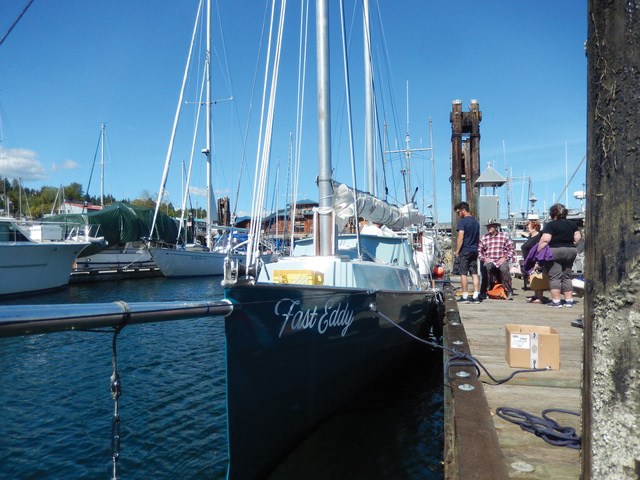This Friday, nearly 50 human and wind powered vessels – rowboats, sailboats, kayaks, catamarans and more – will be setting off from Port Townsend, Wash., to take part in the Race to Alaska.
It’s “North America’s longest human and wind powered race,” according to its website, and at $10,000 for the winner, “the largest cash prize for a race of its kind.”
This year Fast Eddy will be joining the race, a 41-foot (12.5 metre) custom designed schooner built in Gibsons and captained by Tom McPherson of Sechelt.
“We’re basically shooting for completion, definitely not going to be the fastest boat, but the conditions could favour it if it’s very calm. We have a bit of an advantage in that we can row the thing,” said McPherson of the team’s strategy.
He’ll be heading up a six-person crew, one of whom – Ethan Hafey of West Sechelt – is 17 years old, among the youngest in the race. The crew will work in shifts for the duration of the six to nine days expected to complete the journey.
The race is self-supported and self-propelled – only boats without engines are eligible. And it’s not for the faint of heart. Thirty-seven teams competed last year and 21 finished.
The two-stage race starts in Washington, with competitors travelling a “sprint” of 64 kilometres to Victoria. After clearing customs and a day of rest, the 1,143-kilometre stretch begins at noon on June 6. With only two waypoints – Seymour Narrows and Bella Bella – competitors are in charge of their own route to the finish line in Ketchikan, Alaska.
Fast Eddy is up for the challenge, according to McPherson. “It’s ridiculously strong the way it has been put together.”
While the design of the boat came from well-known Florida designer Dudley Dix, its construction happened on the Sunshine Coast. “[It was] quite a huge family and community effort,” McPherson said. “We basically designed a brand new boat from scratch.”
The aesthetic he was aiming for was that of an old style of wood boat known as the Sharpie, which worked North America’s east coast during the 1800s, delivering mail and dragging up oysters. The boats were up to 15 metres long and could be rowed or sailed. “They were essentially a work boat at the end of the age of sailing,” McPherson said.
Fast Eddy’s hull is made of aluminum, but it still takes on the appearance of a wooden boat, and to their knowledge the technique used for plating the hull is unique. It took six months, working six days a week to construct it, with McPherson working alongside John Dearden of Dearden Marine in Gibsons. “It wasn’t necessarily efficient, but the end result was what we’re looking for,” he said.
The boat is named after McPherson’s grandfather, who earned the nickname Fast Eddy playing rugby.
Those interested in following the race can track the team’s progress via the race website, www.r2ak.com. Search for Team Seaforth Expeditions.



